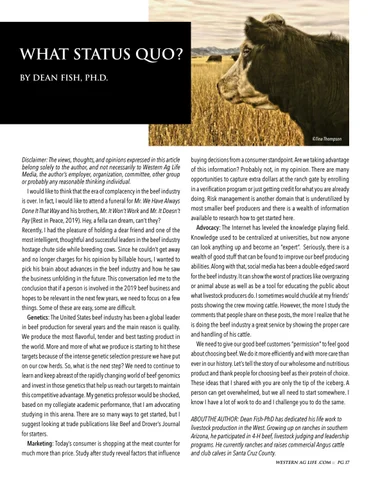WHAT STATUS QUO? BY DEAN FISH, PH.D.
©Tina Thompson
Disclaimer: The views, thoughts, and opinions expressed in this article belong solely to the author, and not necessarily to Western Ag Life Media, the author’s employer, organization, committee, other group or probably any reasonable thinking individual. I would like to think that the era of complacency in the beef industry is over. In fact, I would like to attend a funeral for Mr. We Have Always Done It That Way and his brothers, Mr. It Won’t Work and Mr. It Doesn’t Pay (Rest in Peace, 2019). Hey, a fella can dream, can’t they? Recently, I had the pleasure of holding a dear friend and one of the most intelligent, thoughtful and successful leaders in the beef industry hostage chute side while breeding cows. Since he couldn’t get away and no longer charges for his opinion by billable hours, I wanted to pick his brain about advances in the beef industry and how he saw the business unfolding in the future. This conversation led me to the conclusion that if a person is involved in the 2019 beef business and hopes to be relevant in the next few years, we need to focus on a few things. Some of these are easy, some are difficult. Genetics: The United States beef industry has been a global leader in beef production for several years and the main reason is quality. We produce the most flavorful, tender and best tasting product in the world. More and more of what we produce is starting to hit these targets because of the intense genetic selection pressure we have put on our cow herds. So, what is the next step? We need to continue to learn and keep abreast of the rapidly changing world of beef genomics and invest in those genetics that help us reach our targets to maintain this competitive advantage. My genetics professor would be shocked, based on my collegiate academic performance, that I am advocating studying in this arena. There are so many ways to get started, but I suggest looking at trade publications like Beef and Drover’s Journal for starters. Marketing: Today’s consumer is shopping at the meat counter for much more than price. Study after study reveal factors that influence
buying decisions from a consumer standpoint. Are we taking advantage of this information? Probably not, in my opinion. There are many opportunities to capture extra dollars at the ranch gate by enrolling in a verification program or just getting credit for what you are already doing. Risk management is another domain that is underutilized by most smaller beef producers and there is a wealth of information available to research how to get started here. Advocacy: The Internet has leveled the knowledge playing field. Knowledge used to be centralized at universities, but now anyone can look anything up and become an “expert”. Seriously, there is a wealth of good stuff that can be found to improve our beef producing abilities. Along with that, social media has been a double-edged sword for the beef industry. It can show the worst of practices like overgrazing or animal abuse as well as be a tool for educating the public about what livestock producers do. I sometimes would chuckle at my friends’ posts showing the crew moving cattle. However, the more I study the comments that people share on these posts, the more I realize that he is doing the beef industry a great service by showing the proper care and handling of his cattle. We need to give our good beef customers “permission” to feel good about choosing beef. We do it more efficiently and with more care than ever in our history. Let’s tell the story of our wholesome and nutritious product and thank people for choosing beef as their protein of choice. These ideas that I shared with you are only the tip of the iceberg. A person can get overwhelmed, but we all need to start somewhere. I know I have a lot of work to do and I challenge you to do the same. ABOUT THE AUTHOR: Dean Fish-PhD has dedicated his life work to livestock production in the West. Growing up on ranches in southern Arizona, he participated in 4-H beef, livestock judging and leadership programs. He currently ranches and raises commercial Angus cattle and club calves in Santa Cruz County. WESTERN AG LIFE .COM :: PG 17



















